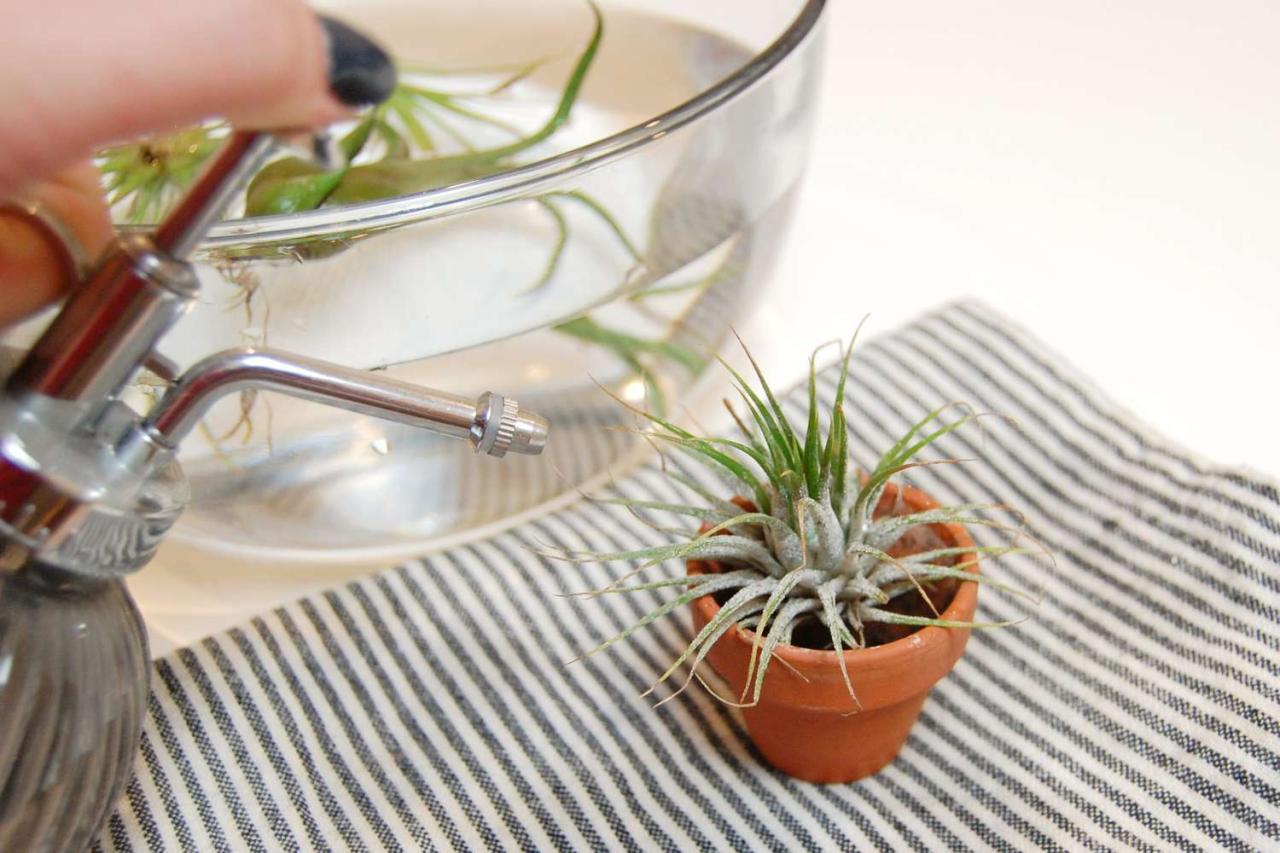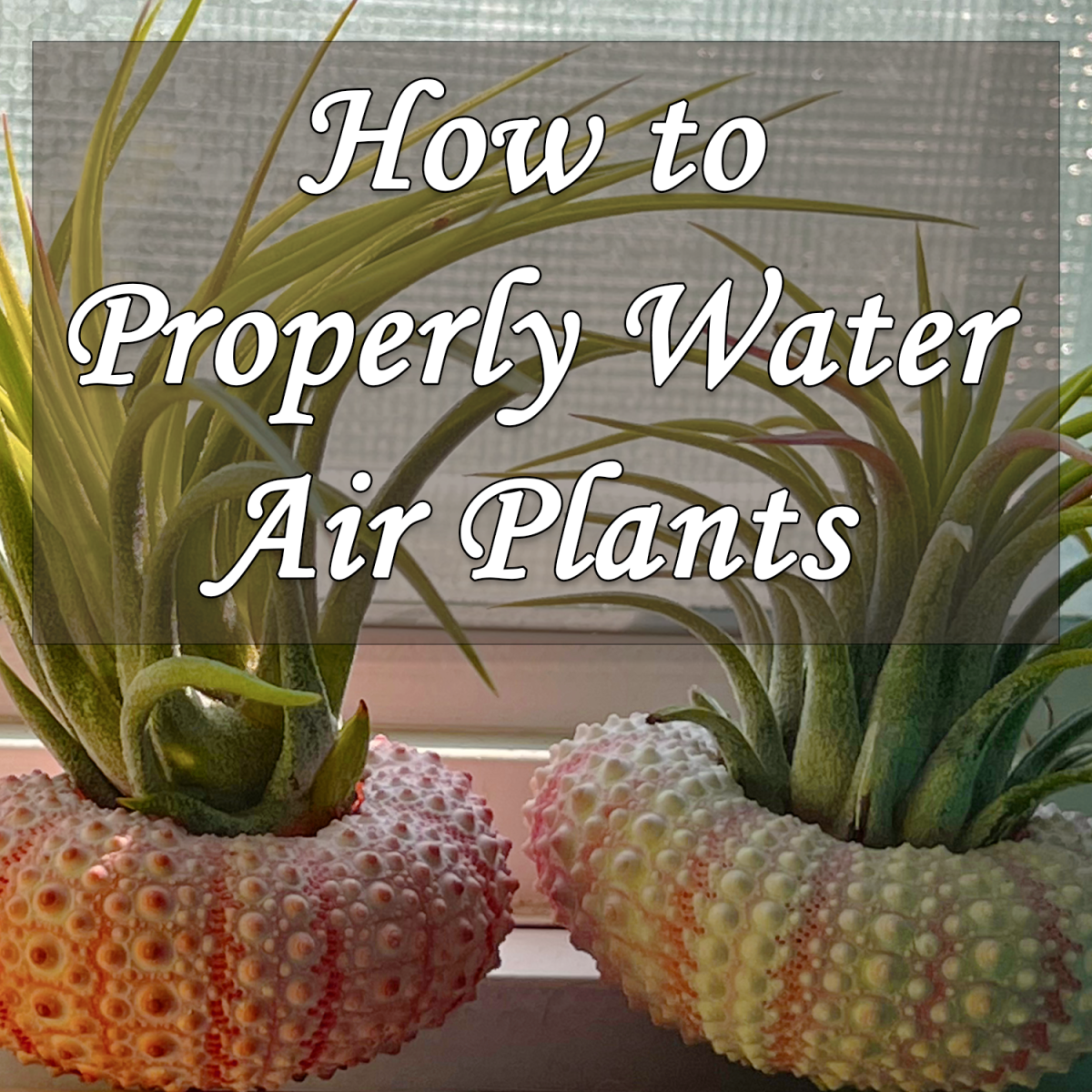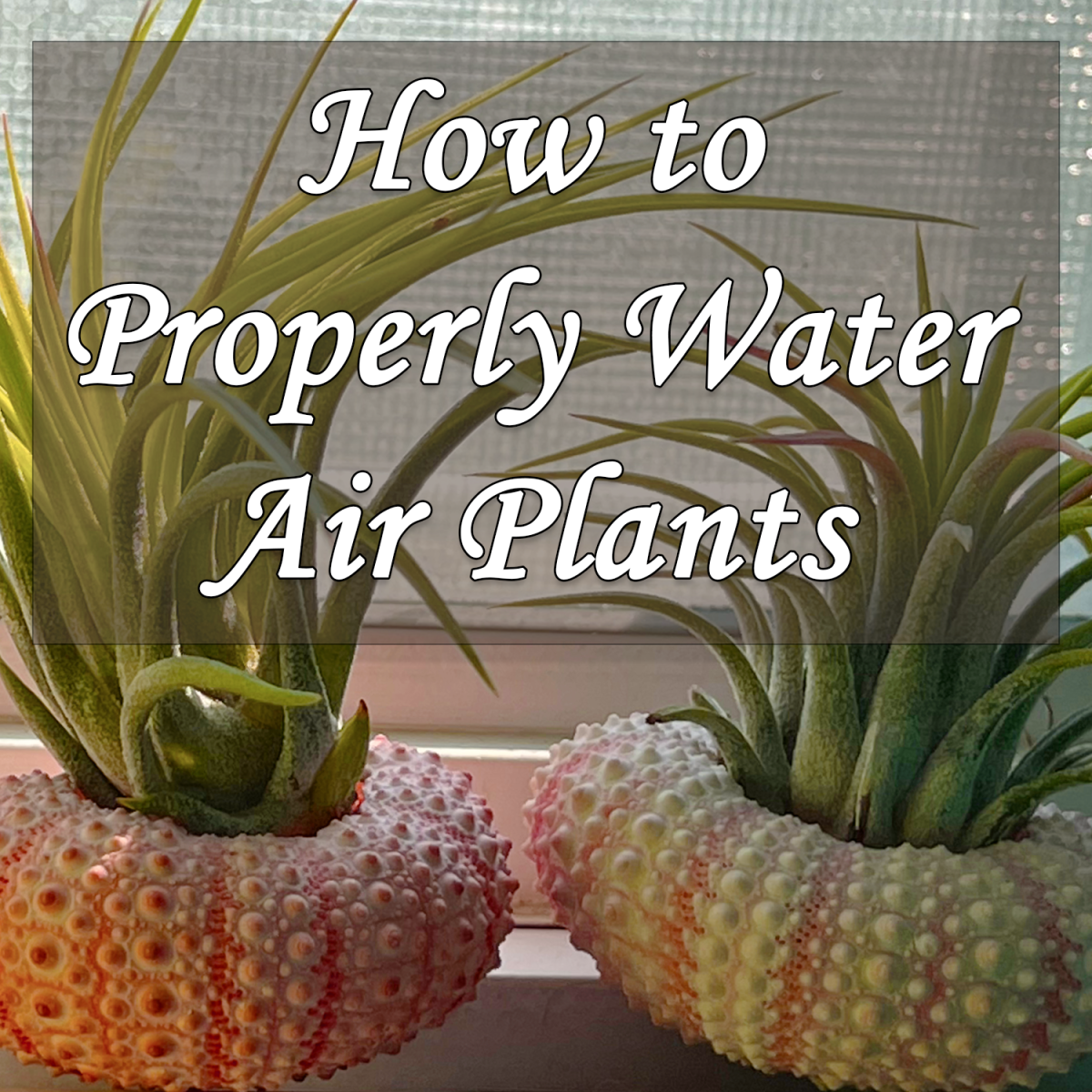The Right Watering Schedule for Your Air Plants is essential for their thriving. Air plants, also known as epiphytes, are fascinating plants that derive their nutrients and moisture from the air, not the soil. Unlike traditional houseplants, air plants don’t require potting or regular soil-based watering.
Instead, they rely on a specific watering routine to maintain their health and vibrant appearance.
This guide delves into the intricacies of air plant watering, providing a comprehensive understanding of their unique needs. From the different types of air plants and their specific watering requirements to the optimal watering techniques and signs of overwatering and underwatering, we’ll equip you with the knowledge to keep your air plants flourishing.
Introduction to Air Plants
Air plants, also known as epiphytes, are fascinating plants that derive their nutrients and moisture from the air rather than soil. These unique plants are not parasitic and do not harm the host plants they grow on. They have adapted to thrive in a variety of environments, from rainforests to deserts.Proper watering is crucial for air plant health.
Since they do not have roots in soil, they rely on their leaves to absorb moisture and nutrients from the air. Understanding the right watering schedule is essential for keeping your air plants thriving.
Importance of Proper Watering
Air plants are resilient but require consistent watering to maintain their health. Overwatering can lead to root rot and fungal infections, while underwatering can cause dehydration and wilting. Finding the right balance is key to ensuring your air plants thrive.
The Right Watering Technique
Watering air plants is a crucial aspect of their care. They are epiphytes, meaning they grow on other plants for support and obtain moisture from the air. While they don’t need to be watered like traditional plants, they still require a regular watering schedule.
Here are the two most common methods.
Soaking Method, The Right Watering Schedule for Your Air Plants
The soaking method is the most effective way to water air plants. It allows the plants to absorb the maximum amount of moisture.
- Duration:Submerge the air plant in a bowl of room-temperature water for 15-30 minutes.
- Frequency:The frequency of soaking depends on the air plant’s species, the humidity level, and the temperature. Generally, air plants need to be soaked once every 1-2 weeks.
Misting Method
While less effective than soaking, misting can be a useful technique for maintaining humidity around air plants.
- Frequency:Mist air plants 1-2 times per day, especially during dry seasons or when temperatures are high.
- Type of Spray:Use a fine mist spray bottle. Avoid using a strong jet spray, as this can damage the plant’s delicate leaves.
Allowing Air Plants to Dry Completely
It is essential to allow air plants to dry completely between waterings. This prevents root rot, a common problem for air plants. After soaking or misting, gently shake off excess water and place the plant in a well-ventilated area to dry.
While air plants are known for their low-maintenance nature, understanding their watering needs is crucial for their well-being. A good watering schedule ensures they thrive, just as choosing the right hanging plants is essential for creating a sense of privacy in your outdoor space, like those featured in Best Hanging Plants to Add Privacy to Your Outdoor Space.
By soaking your air plants in water for 10-15 minutes once a week, you’ll provide them with the moisture they need to flourish.
Signs of Overwatering and Underwatering

Knowing the signs of overwatering and underwatering is crucial for keeping your air plants healthy and thriving. While air plants are resilient, they can be susceptible to these issues if not properly cared for. By understanding the visual cues, you can adjust your watering schedule and ensure your air plants flourish.
Signs of Overwatering
Overwatering is a common problem for air plant owners, often leading to root rot and other issues. Here are some visual cues indicating overwatering:
- Wilting:Overwatering can cause the leaves to become soft, limp, and droopy. This is because the roots are unable to absorb water efficiently, leading to dehydration.
- Discoloration:Overwatering can cause the leaves to turn brown, yellow, or even black. This is due to the buildup of bacteria and fungi in the roots, which can damage the plant’s tissues.
- Root Rot:Overwatering can lead to root rot, which is a serious condition that can kill the plant. The roots will become mushy and may have a foul odor.
Signs of Underwatering
Underwatering is less common than overwatering, but it can still cause problems for air plants. Here are some visual cues indicating underwatering:
- Dry Leaves:Underwatering can cause the leaves to become dry and brittle. This is because the plant is not getting enough water to stay hydrated.
- Browning Tips:Underwatering can cause the tips of the leaves to turn brown and crispy. This is a sign that the plant is dehydrated and needs more water.
- Stunted Growth:Underwatering can stunt the growth of air plants. This is because the plant is not getting enough nutrients to grow properly.
Factors Affecting Watering Frequency
The frequency at which you water your air plants depends on a variety of factors, including the surrounding environment, the plant’s size, and its specific species. Understanding these factors is crucial to providing the optimal watering schedule for your air plants, ensuring their health and longevity.
While air plants are known for their low-maintenance nature, understanding their watering needs is crucial for their thriving. A good watering schedule involves soaking them thoroughly in a bowl of water for 15-20 minutes once a week, allowing them to fully absorb moisture.
This process can be even more enjoyable when you integrate them into a visually appealing display, like a hanging plant wall, as outlined in this helpful guide: How to Create a Hanging Plant Wall in Your Home. Afterward, make sure to shake off excess water and allow them to dry completely, preventing root rot and ensuring their continued health.
Environmental Factors
The environment in which your air plants reside plays a significant role in determining their watering needs. Air plants thrive in environments that mimic their natural habitats, which are typically humid and well-ventilated.
- Temperature:Higher temperatures increase the rate of evaporation, leading to a faster depletion of moisture from the air plants. In warmer climates, you may need to water your plants more frequently. For example, during the summer months, you may need to water your air plants once a week, while during the winter, you may only need to water them once a month.
- Humidity:Air plants thrive in humid environments. If the air is dry, your plants will dry out faster and require more frequent watering. You can increase humidity by misting your plants regularly or placing them near a humidifier.
- Sunlight:Air plants require bright, indirect sunlight. Too much direct sunlight can scorch their leaves, while too little light can lead to stunted growth. The amount of sunlight your plants receive can also affect their watering needs. Plants in direct sunlight may need to be watered more frequently than those in indirect sunlight.
Air Plant Size and Type
The size and type of air plant also influence its watering needs.
- Size:Larger air plants have a greater surface area, allowing them to absorb more moisture. Therefore, they may require watering less frequently than smaller plants.
- Type:Different species of air plants have different watering requirements. Some species, like Tillandsia ionantha, are more drought-tolerant than others, like Tillandsia xerographica. It’s essential to research the specific needs of your air plant species to determine the optimal watering frequency.
Troubleshooting Watering Issues

Even with the best intentions, it’s easy to overwater or underwater air plants. Fortunately, most air plants are resilient and can recover with a little TLC.
Reviving Overwatered Air Plants
Overwatering is a common problem for air plant owners. Overwatering can lead to root rot and eventually death if not addressed. Here are some steps to revive an overwatered air plant:
- Remove the plant from its container. If the plant is in a container, remove it and allow it to dry completely. This will help to prevent further rot.
- Inspect the roots. Look for signs of root rot, such as black or mushy roots. If you see any rot, trim off the affected roots.
- Repot the plant in a well-draining potting mix. If the plant was in a container, repot it in a well-draining potting mix. This will help to prevent future overwatering.
- Water sparingly. Water the plant only when the potting mix is completely dry. Allow the plant to dry completely between waterings.
- Provide good air circulation. Make sure the plant is in a well-ventilated area. This will help to prevent moisture buildup.
Reviving Underwatered Air Plants
Underwatering can also be a problem for air plants. Underwatering can lead to dehydration and eventually death if not addressed. Here are some steps to revive an underwatered air plant:
- Soak the plant in water. Soak the plant in a bowl of water for 15-30 minutes. This will help to rehydrate the plant.
- Allow the plant to dry completely. After soaking, allow the plant to dry completely before placing it back in its container or on its display. This will help to prevent rot.
- Monitor the plant for signs of recovery. The plant should start to show signs of recovery within a few days. If the plant does not show signs of recovery, it may be too far gone.
Preventing Watering Issues
The best way to prevent watering issues is to understand the needs of your air plants. Here are some tips:
- Water your air plants according to their needs. Different air plant species have different watering needs. Some air plants need to be watered more often than others.
- Use the right watering technique. Soaking your air plants in water is the best way to water them. Avoid spraying water directly on the leaves, as this can lead to rot.
- Monitor your air plants for signs of overwatering or underwatering. Air plants will show signs of stress if they are not being watered properly. Look for signs of wilting, yellowing, or brown spots on the leaves.
Creating the Ideal Watering Schedule: The Right Watering Schedule For Your Air Plants
Establishing a proper watering routine is crucial for the health and well-being of your air plants. While they are remarkably resilient, consistent hydration is essential for their growth and vibrant appearance. To create the ideal watering schedule, it’s important to consider both the specific air plant variety and the environmental conditions in which they are kept.
Watering Frequency for Different Air Plant Varieties
Air plants, scientifically known as Tillandsia, exhibit a diverse range of characteristics, including their water requirements. Some species, like Tillandsia ionantha(Pink Quill), are more drought-tolerant, while others, like Tillandsia xerographica(Xerographica), require more frequent watering. The table below provides a general guideline for watering frequency based on common air plant varieties:
Air Plant Variety |
Recommended Watering Frequency |
|---|---|
Tillandsia ionantha (Pink Quill) |
Every 10-14 days |
Tillandsia xerographica (Xerographica) |
Every 7-10 days |
Tillandsia aeranthos (Sky Plant) |
Every 7-10 days |
Tillandsia cyanea (Pink Quill) |
Every 7-10 days |
Tillandsia bulbosa (Bulbous Air Plant) |
Every 7-10 days |
Tillandsia usneoides (Spanish Moss) |
Every 10-14 days |
Closing Summary
Mastering the art of air plant watering is key to cultivating these enchanting plants. By understanding their unique needs, implementing the right watering techniques, and recognizing the signs of overwatering and underwatering, you can ensure your air plants thrive in your care.
With the knowledge gained from this guide, you can create a thriving air plant collection that adds a touch of nature’s beauty to your home.
FAQ Overview
How often should I water my air plants?
The frequency of watering depends on the type of air plant, the environment, and the season. Generally, air plants should be soaked once a week during warmer months and less frequently during colder months. It’s important to allow them to dry completely between waterings.
What happens if I overwater my air plants?
Overwatering can lead to root rot, which can damage or kill your air plants. Signs of overwatering include wilting, discoloration, and a foul odor. If you suspect overwatering, immediately remove the plant from any standing water and allow it to dry thoroughly.
What are the best types of water to use for air plants?
It’s best to use rainwater or distilled water for air plants. Tap water can contain minerals that can build up on the plant’s leaves and hinder their growth. Avoid using softened water as it can be too salty for air plants.
